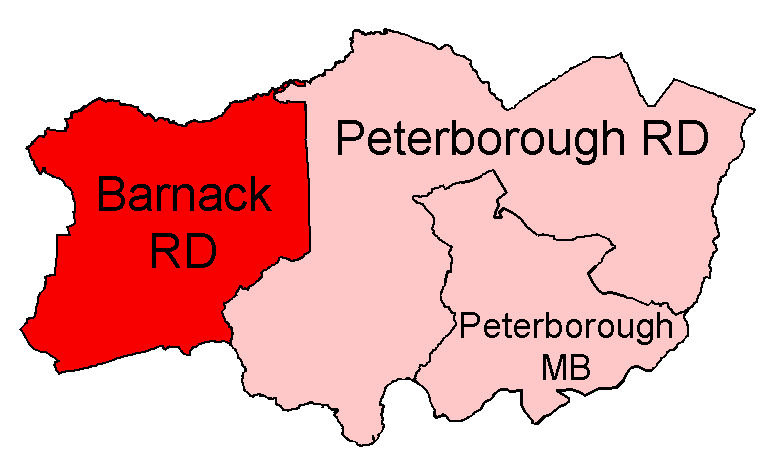|
Barnack
Barnack is a village and civil parish in the Peterborough unitary authority of the ceremonial county of Cambridgeshire, England and the historic county of Northamptonshire. Barnack is in the north-west of the unitary authority, south-east of Stamford, Lincolnshire. The parish includes the hamlet of Pilsgate about northwest of Barnack. Both Barnack and Pilsgate are on the B1443 road. The 2021 Census recorded a parish population of 1000. Barnack is historically part of the Soke of Peterborough, which was associated with Northamptonshire but had its own County Council from 1888 until 1965. From 1894 until 1965 there was a Barnack Rural District that was a subdivision of the Soke, and which formed part of Huntingdon and Peterborough until 1974. Barnack is notable for its former limestone industry, its Anglo-Saxon parish church and an unusual early Bronze Age burial. Hills and Holes, an area of Roman and later quarrying, is now a nature reserve. The Barnack burial The Barnac ... [...More Info...] [...Related Items...] OR: [Wikipedia] [Google] [Baidu] |
Barnack Hills & Holes National Nature Reserve
Barnack Hills & Holes is a biological Site of Special Scientific Interest in Barnack in Cambridgeshire. It is also a national nature reserve. It is a Nature Conservation Review site, Grade I. In 2002 it was designated as a Special Area of Conservation, to protect the orchid-rich grassland as part of the Natura 2000 network of sites throughout the European Union. Arising from the rubble of a medieval quarry, the Hills and Holes is one of Britain’s most important wildlife sites. Covering an area of just 50 acres (22 ha), the grassy slopes are home to a profusion of wild flowers. This type of meadowland is now all too rare; half of the surviving limestone grassland in Cambridgeshire is found here. In 2002 it was designated as a Special Area of Conservation, to protect the orchid-rich grassland as part of the Natura 2000 network of sites throughout the European Union. The hummocky landscape was created by quarrying for limestone. Barnack stone, was a valuable building sto ... [...More Info...] [...Related Items...] OR: [Wikipedia] [Google] [Baidu] |
Stone Wrist-guard
Early Bronze Age stone wrist-guards are found across Europe from around 2400-1900 BC and are closely associated with the Beaker culture and Únětice culture. In the past they have been variously known as ''stone bracers'', ''stone arm-guards'' and ''armlets'', although "stone wrist-guard" is currently the favoured terminology; and it is no longer thought that they were functional archer's bracers. Description The wrist-guards are small rectangles of stone (often slate) with a number of perforations, typically between two and six, which might allow attachment to the arm with cord. One, from Hemp Knoll in Wiltshire, had markings which clearly indicate its attachment to the arm by two cords. The shapes of the wrist-guard are stereotyped, and common forms exhibit a narrowed 'waist' and curved cross-section (presumably so they fit the arm better). Stone wrist-guards are exclusively found in the graves of males, frequently lying next to the body's wrist. Rare examples – three in ... [...More Info...] [...Related Items...] OR: [Wikipedia] [Google] [Baidu] |
Stamford, Lincolnshire
Stamford is a market town and civil parish in the South Kesteven district of Lincolnshire, England. The population at the 2011 census was 19,701 and estimated at 20,645 in 2019. The town has 17th- and 18th-century stone buildings, older timber-framed buildings and five medieval parish churches. Stamford is a frequent film location. In 2013 it was rated a top place to live in a survey by ''The Sunday Times''. Its name has been passed on to Stamford, Connecticut, founded in 1641. Etymology The place-name Stamford is first attested in the Anglo-Saxon Chronicle, where it appears as ''Steanford'' in 922 and ''Stanford'' in 942. It appears as ''Stanford'' in the Domesday Book of 1086. The name means "stony ford". History Roman and Medieval Stamford image:Stamford features (32) - geograph.org.uk - 7139889.jpg, 250px, Stamford The Romans built Ermine Street across what is now Burghley Park and forded the River Welland to the west of Stamford, eventually reaching Lincoln, England, ... [...More Info...] [...Related Items...] OR: [Wikipedia] [Google] [Baidu] |
Soke Of Peterborough
The Soke of Peterborough is a historic area of England associated with the City and Anglican Diocese of Peterborough, Diocese of Peterborough. It was part of Northamptonshire, but was administered by Soke of Peterborough County Council, its own county council, while the rest of Northamptonshire was administered by Northamptonshire County Council. The Soke (legal), Soke was also described as the Liberty (division), Liberty of Peterborough, or as the Nassaburgh Hundred (country subdivision), hundred, and comprised, besides Peterborough, about thirty parishes. The Soke was abolished in 1965. The area formed much of the present City of Peterborough unitary authority area in the post-1974 ceremonial county of Cambridgeshire. The Church of England dioceses of Peterborough and Diocese of Ely, Ely still, however, follow the boundary of the Soke, with only the part of the city that is north of the River Nene lying within the Diocese of Peterborough, while urban areas south of the Nene, ... [...More Info...] [...Related Items...] OR: [Wikipedia] [Google] [Baidu] |
Pilsgate
Pilsgate is a hamlet and former civil parishes in England, civil parish, now in the parish of Barnack, in the City of Peterborough, Peterborough district, in the ceremonial county of Cambridgeshire, England. Pilsgate is close to the county boundary and south-east of Stamford, Lincolnshire. In 1881 the parish had a population of 125. History Pilsgate was recorded in the Domesday Book as ''Pillesgate''. From 1866 Pilsgate was a civil parish in its own right until it was abolished on 24 March 1887 and merged with Barnack. References External links * Hamlets in Cambridgeshire Former civil parishes in Cambridgeshire Barnack {{Cambridgeshire-geo-stub ... [...More Info...] [...Related Items...] OR: [Wikipedia] [Google] [Baidu] |
Barnack Rural District
Barnack was a rural district in the Soke of Peterborough and later Huntingdon and Peterborough from 1894 to 1974. It was created in 1894 under the Local Government Act 1894, from that part of the Stamford rural sanitary district which was in the Soke (the rest formed either Ketton Rural District in Rutland, Easton on the Hill Rural District in Northamptonshire proper, or Uffington Rural District in Lincolnshire, Parts of Kesteven). It included the parishes of Bainton, Barnack, Southorpe, Stamford Baron, St Martins Without, Thornhaugh, Ufford, Wansford, Wittering and Wothorpe in the Soke. It also had administrative responsibility for the parish of Sibson cum Stibbington, which was over the border in Huntingdonshire. This was made part of the Norman Cross Rural District in 1935.The County of Huntingdon Review Order 1934, Ministry of Health Order No. 79915 It was abolished in 1974 under the Local Government Act 1972, becoming part of the larger Peterborough distri ... [...More Info...] [...Related Items...] OR: [Wikipedia] [Google] [Baidu] |
Local Government In Peterborough
The City of Peterborough, is a district with city status in the ceremonial county of Cambridgeshire, England. The district is named after its largest settlement, Peterborough, but also covers a wider area of outlying villages and hamlets. The district is administered by Peterborough City Council, a unitary authority. The district's area covers parts of the historic counties of Northamptonshire and Huntingdonshire, as well as a small part of Cambridgeshire. In 1965, the area became part of the short-lived county of Huntingdon and Peterborough before becoming a district of Cambridgeshire in 1974. Located in the East Anglia region of England, the area borders the surrounding counties of Lincolnshire and Northamptonshire. The population of the district was 202,259 making it the second-largest district by population in East Anglia (after East Suffolk). Most of the contemporary district was formerly part of the Soke of Peterborough, a liberty within the historic county of Northamp ... [...More Info...] [...Related Items...] OR: [Wikipedia] [Google] [Baidu] |
North West Cambridgeshire (UK Parliament Constituency)
North West Cambridgeshire is a county constituency represented in the British House of Commons, House of Commons of the Parliament of the United Kingdom since 2024 by Sam Carling of the Labour Party (UK), Labour Party. It elects one Member of Parliament (MP) by the first past the post system of election. Constituency profile This seat includes a substantial part of the cathedral city of Peterborough, specifically the suburban areas to the south of the river Nene and west of the Soke Parkway, as well as several rural wards from the historic county of Huntingdonshire. The London Road Stadium, London Road home of Peterborough United F.C. is located within the seat. History The seat was won upon its creation in 1997 by Brian Mawhinney, Sir Brian Mawhinney, former Conservative MP for Peterborough (which was gained at the same election by the Labour Party). He retired from the House of Commons in 2005 and was created Baron Mawhinney, of Peterborough in the county of Cambridgesh ... [...More Info...] [...Related Items...] OR: [Wikipedia] [Google] [Baidu] |
City Of Peterborough
The City of Peterborough, is a district with City status in the United Kingdom, city status in the ceremonial county of Cambridgeshire, England. The district is named after its largest settlement, Peterborough, but also covers a wider area of outlying villages and hamlets. The district is administered by Peterborough City Council, a Unitary authorities of England, unitary authority. The district's area covers parts of the Historic counties of England, historic counties of Northamptonshire and Huntingdonshire, as well as a small part of Cambridgeshire. In 1965, the area became part of the short-lived county of Huntingdon and Peterborough before becoming a district of Cambridgeshire in 1974. Located in the East Anglia region of England, the area borders the surrounding counties of Lincolnshire and Northamptonshire. The population of the district was 202,259 making it the second-largest district by population in East Anglia (after East Suffolk District, East Suffolk). Most of the ... [...More Info...] [...Related Items...] OR: [Wikipedia] [Google] [Baidu] |
Huntingdon And Peterborough
Huntingdon and Peterborough was a short-lived administrative county, administrative and Geographical counties of England, geographical county in East Anglia in the United Kingdom. It existed from 1965 to 1974, when it became part of Cambridgeshire. Formation The Local Government Act 1888 created four small neighbouring administrative counties in the east of England: Cambridgeshire, Isle of Ely, Huntingdonshire, and the Soke of Peterborough. Following the Second World War, a Local Government Boundary Commission (1945–1949), Local Government Boundary Commission was formed to review county-level administration in England and Wales. The commission was of the opinion that counties needed to have a population of between 200,000 and one million in order to provide effective services. Accordingly, they recommended the amalgamation of all four counties into a single entity. The commission's recommendations were not carried out, however. The reform of local government was returned to i ... [...More Info...] [...Related Items...] OR: [Wikipedia] [Google] [Baidu] |
Beaker Culture
The Bell Beaker culture, also known as the Bell Beaker complex or Bell Beaker phenomenon, is an archaeological culture named after the inverted-bell Beaker (archaeology), beaker drinking vessel used at the beginning of the European Bronze Age, arising from around 2800 BC. The term's English translation ''Bell Beaker'' was introduced by John Abercromby, 5th Baron Abercromby, John Abercromby in 1904.''The Concise Oxford Dictionary of Archaeology'' Bell Beaker culture lasted in Bronze Age Britain, Britain from BC, with the appearance of single burial graves,Armit, Ian, and David Reich, (2022)"What do we know about the Beaker Folk" in: Antiquity Journal, Youtube, min: 1:11: "So, the Beaker Complex in terms of Great Britain and Ireland is from ... around 2450 BC, when we see in Britain the appearance of single inhumation graves ...." until as late as 1800 BC, but in continental Europe only until 2300 BC, when it was succeeded by the Únětice culture. The culture was wide ... [...More Info...] [...Related Items...] OR: [Wikipedia] [Google] [Baidu] |







